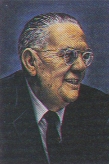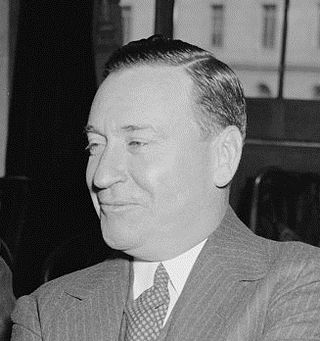Related Research Articles

John Llewellyn Lewis was an American leader of organized labor who served as president of the United Mine Workers of America (UMW) from 1920 to 1960. A major player in the history of coal mining, he was the driving force behind the founding of the Congress of Industrial Organizations (CIO), which established the United Steel Workers of America and helped organize millions of other industrial workers in the 1930s, during the Great Depression. After resigning as head of the CIO in 1941, thus keeping his promise of resignation if President Franklin Delano Roosevelt won the 1940 election against Wendell Willkie, Lewis took the United Mine Workers out of the CIO in 1942 and in 1944 took the union into the American Federation of Labor (AFL).

The United Mine Workers of America is a North American labor union best known for representing coal miners. Today, the Union also represents health care workers, truck drivers, manufacturing workers and public employees in the United States and Canada. Although its main focus has always been on workers and their rights, the UMW of today also advocates for better roads, schools, and universal health care. By 2014, coal mining had largely shifted to open pit mines in Wyoming, and there were only 60,000 active coal miners. The UMW was left with 35,000 members, of whom 20,000 were coal miners, chiefly in underground mines in Kentucky and West Virginia. However it was responsible for pensions and medical benefits for 40,000 retired miners, and for 50,000 spouses and dependents.
The Communist Party (CP) and its allies played a role in the United States labor movement, particularly in the 1930s and 1940s, but largely wasn't successful either in bringing the labor movement around to its agenda or in converting their influence in any particular union into membership gains for the Party. The CP has had only negligible influence in labor since its supporters' defeat in internal union political battles in the aftermath of World War II and the Congress of Industrial Organizations's (CIO) expulsion of unions in which the party held the most influence in 1950. The expelled parties were often raided by stronger unions, and most withered away.

Sidney Hillman was an American labor leader. He was the head of the Amalgamated Clothing Workers of America and was a key figure in the founding of the Congress of Industrial Organizations and in marshaling labor's support for President Franklin D. Roosevelt and the New Deal coalition of the Democratic Party.

William Julian Usery Jr. was an American labor union activist and government appointee who served as United States secretary of labor in the Ford administration.

Philip Murray was a Scottish-born steelworker and an American labor leader. He was the first president of the Steel Workers Organizing Committee (SWOC), the first president of the United Steelworkers of America (USWA), and the longest-serving president of the Congress of Industrial Organizations (CIO).

The Coal strike of 1902 was a strike by the United Mine Workers of America in the anthracite coalfields of eastern Pennsylvania. Miners struck for higher wages, shorter workdays, and the recognition of their union. The strike threatened to shut down the winter fuel supply to major American cities. At that time, residences were typically heated with anthracite or "hard" coal, which produces higher heat value and less smoke than "soft" or bituminous coal.
The National Labor Board (NLB) was an independent agency of the United States Government established on August 5, 1933, to handle labor disputes arising under the National Industrial Recovery Act (NIRA).
The Steel Workers Organizing Committee (SWOC) was one of two precursor labor organizations to the United Steelworkers. It was formed by the CIO on June 7, 1936. It disbanded in 1942 to become the United Steel Workers of America. The Steel Labor was the official paper of SWOC.

Emil Rieve was an American labor leader. He was president of the Textile Workers Union of America (TWUA) from 1939 to 1956, a vice president of the Congress of Industrial Organizations (CIO) from 1939 to 1955, and a vice president of the AFL-CIO from 1955 to 1960.

George W. Taylor was a professor of industrial relations at the Wharton School at the University of Pennsylvania, and is credited with founding the academic field of study known as industrial relations. He served in several capacities in the federal government, most notably as a mediator and arbitrator. During his career, Taylor settled more than 2,000 strikes.

The 1952 steel strike was a strike by the United Steelworkers of America (USWA) against U.S. Steel (USS) and nine other steelmakers. The strike was scheduled to begin on April 9, 1952, but US President Harry Truman nationalized the American steel industry hours before the workers walked out. The steel companies sued to regain control of their facilities. On June 2, 1952, in a landmark decision, the US Supreme Court ruled in Youngstown Sheet & Tube Co. v. Sawyer, 343 U.S. 579 (1952), that the President lacked the authority to seize the steel mills. The strike involved 560,000 workers.
Cyrus S. Ching was a Canadian-American who became an American industrialist, federal civil servant, and noted labor union mediator. He was the first director of the Federal Mediation and Conciliation Service (FMCS) and the Wage Stabilization Board.
Benjamin Aaron was an American attorney, labor law scholar and civil servant. He is known for his work as an arbitrator and mediator, and for helping to advance the development of the field of comparative labor law in the United States.

Benjamin Franklin Fairless was an American steel company executive. He was president of a wide range of steel companies during a turbulent and formative period in the American steel industry. His roles included President of Central Alloy Steel from 1928 to 1930; First Vice President of Republic Steel from 1930 to 1935; President of the Carnegie-Illinois Steel Company from 1935 to 1938; and then President (1938–1955), and later Chief Executive Officer and Chairman of the board of directors (1952–1955) of U.S. Steel, the largest steel corporation in the United States.

The Congress of Industrial Organizations (CIO) was a federation of unions that organized workers in industrial unions in the United States and Canada from 1935 to 1955. Originally created in 1935 as a committee within the American Federation of Labor (AFL) by John L. Lewis, a leader of the United Mine Workers (UMW), and called the Committee for Industrial Organization. Its name was changed in 1938 when it broke away from the AFL. It focused on organizing unskilled workers, who had been ignored by most of the AFL unions.
The National War Labor Board, commonly the War Labor Board, was an independent agency of the United States government, established January 12, 1942, by an executive order of President Franklin D. Roosevelt, the purpose of which was to mediate labor disputes as part of the American home front during World War II.
Meyer Bernstein (1914–1985) was a 20th-Century American labor leader and educator who worked for the Steel Workers Organizing Committee (SWOC), the United Steel Workers of America (USWA), the U.S. Department of Labor, and the United Mine Workers of America (UMW).
The first-ever "political action committee" in the United States of America was the Congress of Industrial Organizations – Political Action Committee or CIO-PAC (1943–1955). What distinguished the CIO-PAC from previous political groups was its "open, public operation, soliciting support from non-CIO unionists and from the progressive public. ... Moreover, CIO political operatives would actively participate in intraparty platform, policy, and candidate selection processes, pressing the broad agenda of the industrial union movement."

Strikes in the United States in the 1930s played a major role in reshaping the economy as it recovered from the Great Depression. Unions gained millions of members for unions in the American Federation of Labor (AFL)and the new Congress of Industrial Organizations (CIO). Energized by successful strikes in major industries with the help of New Deal agencies, the unions played a major role in Democratic Party efforts to reelect President Franklin D. Roosevelt in 1936, as well as 1940 and 1944.
References
- 1 2 3 Jaffe, Louis Leventhal; Rice, William; United States. Bureau of Labor Statistics (1942). Report on the Work of the National Defense Mediation Board, March 19, 1941 – January 12, 1942: Bulletin of the United States Bureau of Labor Statistics, No. 714. G.P.O.
- 1 2 3 4 5 Atleson, 1998: 30
- 1 2 3 4 5 6 7 8 9 10 Bernstein
- 1 2 3 Atleson, 1998: 20
- ↑ Atleson, 1998: 20; Bernstein
- ↑ Atleson, 1998: 21
- ↑ Atleson, 1998: 29
- ↑ Atleson, 1998: 29-30
- 1 2 3 Atleson, 1998: 31
- ↑ Atleson, 1998: 31; U.S., 1950: 5
- ↑ Marcus, 1994: 285; Atleson, 1998: 31
- 1 2 Atleson, 1998: 32
- 1 2 Atleson, 1998: 31; Freidin, 1943: 82-3
- ↑ U.S., 1950: 6
- ↑ Bernstein; Workman, 2000: 250
- ↑ Freidin, 1943: 81
- Atleson, James B. 1998. Labor and the Wartime State. Chicago: University of Illinois Press.
- Bernstein, Irving. “Chapter 5: Americans in Depression and War.” http://www.dol.gov/oasam/programs/history/chapter5.htm.
- Friedin, Jesse. 1943. “The National War Labor Board: An Achievement in Tri-Partite Administration.” Science & Society, 7(1): 80–87.
- Marcus, Maeva. 1994. Truman and the Steel Seizure Case: The Limits of Presidential Power. Durham: Duke University Press.
- United States Department of Labor and Bureau of Labor Statistics. Problems and Policies of Dispute Settlement and Wage Stabilization During World War II. December 15, 1950.
- Workman, Andrew A. 2000. “Creating the National War Labor Board: Franklin Roosevelt and the Politics of State Building in the Early 1940s.” Journal of Policy History, 12(2): 233–264.